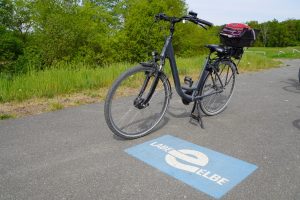The museum Historischer Lokschuppen Wittenberge is located very close to Wittenberge railway station. Here, the Dampflokfreunde Salzwedel e.V. association has created a dream for steam locomotive fans.

Sometimes it’s amazing to hear the story of how an association was founded and how a museum came into being. Shortly after the fall of the Wall, someone realised his dream and bought some discarded steam locomotives from the former German Reichsbahn. In 1994, the Verein der Dampflokfreunde Salzwedel e.V. was founded with the aim of preserving the old locomotives and showing them to visitors in a museum.
The club was active in Salzwedel for a good 18 years and then decided to look for a new home for a variety of reasons. The railway depot in Wittenberge offered the opportunity to take over a large locomotive shed and additional grounds. By the end of 2012, they had moved to the town on the Elbe with their trains. To this day, the facility is being renovated and refurbished, the locomotives are being tinkered with and, at weekends and special events, visitors are offered the opportunity to immerse themselves in the world of steam locomotives.

Historic locomotive shed Wittenberge – what can you experience?
To get to the historic locomotive shed, you first pass the gatehouse of the former Wittenberge railway depot. Behind it is an area criss-crossed by rails, which is still partly used as a depot today.

First we go to the locomotive service building, where today the entrance to the museum is located and where you can buy tickets. In the past, the building served the so-called locomotive duty managers. The locomotive crew reported for duty in an office.
It’s up to you to decide how you want to spend your visit to the Historic Engine Shed in Wittenberge. You can first go on a discovery tour in the building or explore the huge open-air grounds.

The locomotive shed
The locomotive shed (built in 1924) is a large round shed that was still in operation until 1996. Originally, 19 tracks led into the shed. After three sections in the locomotive shed were converted (to workshops and storage areas), 16 tracks still lead into the building today.
After regular operations in the locomotive shed had been discontinued, the building deteriorated more and more and was only secured in a makeshift manner. The Steam Locomotive Friends Association had a lot of work to do when they took over the site in order to preserve the historic building. A small exhibition in the building contains interesting pictures and information about this work.

You enter the locomotive shed through a long corridor that runs behind the tracks in the shed. In the corridor are historical signs that were found in stations and railway lines.
When we entered the large area of the round shed, it first took my breath away. Close together, on every track, are the most diverse locomotives and wagons. Some are being diligently screwed together, others are polished to a high sheen and look as if they could set off immediately. Railway connoisseurs will certainly say immediately on their tour – ah that’s the… For us, they are simply impressive and beautiful machines.

As there are almost no signs on the locomotives, I was quite happy to be shown around by someone who knows the locomotives. When we climbed into the driver’s cab of a steam locomotive, they explained the principle of the steam engine and we learned a lot about the work of the driver and the stoker. Did you know that it takes 5-6 hours to heat a boiler?

Steam locomotive Emma
Emma was built in the 1920s by the Hannoverian company Hanomag. The locomotive, which is located in Wittenberge, was used in a sugar factory in Rethe to shunt freight wagons until 1960. Then it was “retired” and stood around unused for a while. In the 1970s, an enthusiast bought it and put it in his garden.

When the locomotive was put up for sale in 2008, a track contractor bought it. His goal was to get Emma running again. It took a good 2 years until the little locomotive was operational again. Since 2010, it has been in the Historic Locomotive Shed in Wittenberge and people like to use it for cab rides.
Steam locomotive Pritzwalk
The Pritzwalk is a steam locomotive that was built in Kassel in 1912. It was used as a shunting locomotive by the Frankfurt gas company. In 1971, the locomotive was parked, then sold, erected as a monument, sold again, used for advertising … and finally arrived in Wittenberge. Since 2019, the locomotive has been in the Historic Locomotive Shed in Wittenberge.

Diesel locomotive V 320 001-1
In addition to the steam locomotives, there are also some diesel locomotives in the museum. The V320 001 was manufactured as a single unit in 1962 and is one of the largest diesel locomotives in the Federal Republic of Germany. It initially ran in trial service on the German Federal Railway and reached top speeds of 180 km/h. However, the Federal Railway decided against it. However, the Bundesbahn decided against purchasing further vehicles of this type.

It then ran for the Allgäubahn for a while until it was badly damaged in May 1967 in Kaufering station by a collision with a shunting locomotive. After repairs, the locomotive was used by various companies, for example in Italy. In 1998, a track construction company bought this impressive locomotive and since 2020 it has been on permanent loan in Wittenberge.
Rail Trabi – Track Motorcycle Type 1
I was particularly impressed by the rail Trabbi, which immediately catches the eye because of its bright yellow colour. The motorised Trabbi can carry 2 people. Powered by a Trabbi engine, this vehicle was used to control tracks.

Out and about in the grounds of the Historic Engine Shed Wittenberge
After seeing the beautiful locomotives in the engine shed, you can explore the outside area and the wagons and locomotives standing there.

First it goes along the large turntable. The incoming locomotives are turned on this layout and can thus be distributed in the locomotive shed. It can be driven electrically, by compressed air or by muscle power.
The water tower with its water crane is still in operation. There is a huge steel tank with water in the tower. Steam locomotives can fill up their tanks here.

Of course, you will also find numerous wagons and locomotives on the museum grounds. For example, it is exciting to see a car transport wagon that belonged to the GDR’s first government train. Fortunately, the wagon was saved from being scrapped.

Disaster train
I find the disaster train particularly exciting. The wagons that are here in Wittenberge were originally intended to provide care for injured and sick people in the event of natural disasters or serious accidents. There were 14 of these trains in the GDR, but they were mostly used in manoeuvres as mobile hospitals or to transport sick or injured soldiers of the Soviet armed forces.

The train consisted of two bed wagons with three-storey bunk beds, a supply wagon, a kitchen wagon, a machine wagon and a fully equipped emergency surgery wagon. One emergency surgery car, one kitchen car and one machine car are in Wittenberge.
Historic locomotive shed Wittenberge – is it worth it?
We enjoyed the visit. The association runs the museum with a lot of energy, enthusiasm and love for the railway. We spent almost two hours on the grounds and there was so much more to discover. We definitely plan to visit the historic locomotive shed again, then during an event, to see the beautiful vehicles in action.

Address:
Am Bahnhof 6
19322 Wittenberge
Opening hours outside the events:
Beginning of April -Mid October
Saturday: 10-17 h (last admission 16:00 h)
Special events take place on some weekends during the year.
Admission price outside the events:
Adults: 5,00 €

The visit to the Historic Engine Shed Wittenberge took place as part of a research trip.




Leave a Reply